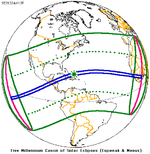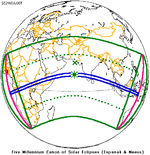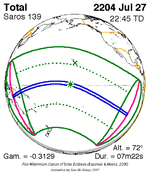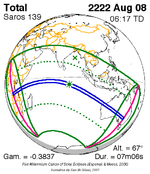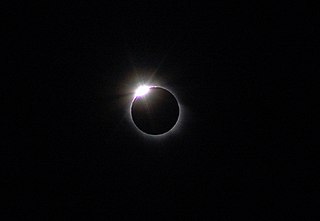
A total solar eclipse occurred on March 29, 2006. A solar eclipse occurs when the Moon passes between Earth and the Sun, thereby totally or partly obscuring the image of the Sun for a viewer on Earth. A total solar eclipse occurs when the Moon's apparent diameter is larger than the Sun's, blocking all direct sunlight, turning day into darkness. Totality occurs in a narrow path across Earth's surface, with the partial solar eclipse visible over a surrounding region thousands of kilometres wide. It was visible from a narrow corridor which traversed half the Earth. The magnitude, that is, the ratio between the apparent sizes of the Moon and that of the Sun, was 1.052, and it was part of Saros 139.
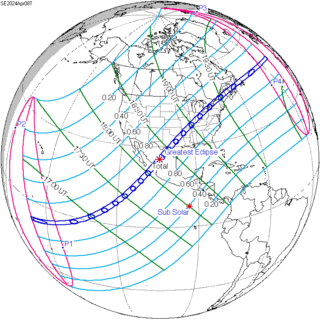
A total solar eclipse will take place at the Moon's ascending node of the orbit on April 8, 2024, visible across North America and dubbed the Great North American Eclipse by some of the media. A solar eclipse occurs when the Moon passes between Earth and the Sun, thereby obscuring the image of the Sun for a viewer on Earth. A total solar eclipse occurs when the Moon's apparent diameter is larger than the Sun's, blocking all direct sunlight, turning day into darkness. Totality occurs in a narrow path across Earth's surface, with the partial solar eclipse visible over a surrounding region thousands of kilometres wide.

A total solar eclipse will occur at the Moon's ascending node of the orbit on June 13, 2132. A solar eclipse occurs when the Moon passes between Earth and the Sun, thereby totally or partly obscuring the image of the Sun for a viewer on Earth. A total solar eclipse occurs when the Moon's apparent diameter is larger than the Sun's, blocking all direct sunlight, turning day into darkness. Totality occurs in a narrow path across Earth's surface, with the partial solar eclipse visible over a surrounding region thousands of kilometres wide. This is one of the solar eclipses occurring on Friday the 13th.
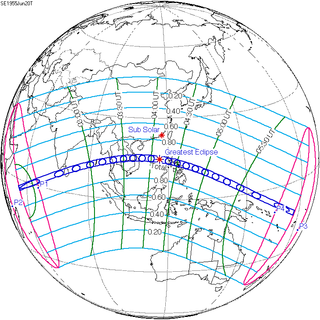
A total solar eclipse occurred on June 20, 1955. A solar eclipse occurs when the Moon passes between Earth and the Sun, thereby totally or partly obscuring the image of the Sun for a viewer on Earth. A total solar eclipse occurs when the Moon's apparent diameter is larger than the Sun's, blocking all direct sunlight, turning day into darkness. Totality occurs in a narrow path across Earth's surface, with the partial solar eclipse visible over a surrounding region thousands of kilometres wide. With a maximum duration of 7 minutes 7.74 seconds, this is the longest solar eclipse of saros series 136, as well as the longest total solar eclipse since the 11th century, and until the 22nd century, because greatest eclipse occurred near the Equator. Totality beginning over the Indian Ocean, British Seychelles and Maldives, crossing Ceylon including the capital city Colombo, Andaman Islands, Burma, Thailand including the capital city Bangkok, Cambodia, Laos, South Vietnam, Paracel Islands and Scarborough Shoal, moving across the Philippines including the capital city Manila, Kayangel Atoll in the Trust Territory of the Pacific Islands, Nukumanu Islands in the Territory of Papua New Guinea, towards northern Ontong Java Atoll in British Solomon Islands ending over Southwestern Pacific Ocean. It was the second central solar eclipse visible from Bangkok from 1948 to 1958, where it is rare for a large city to witness 4 central solar eclipses in just 9.945 years.

A total solar eclipse will occur on April 20, 2042. A solar eclipse occurs when the Moon passes between Earth and the Sun, thereby totally or partly obscuring the image of the Sun for a viewer on Earth. A total solar eclipse occurs when the Moon's apparent diameter is larger than the Sun's, blocking all direct sunlight, turning day into darkness. Totality occurs in a narrow path across Earth's surface, with the partial solar eclipse visible over a surrounding region thousands of kilometres wide. It will be seen significantly in Western Indonesia, Eastern Malaysia, Brunei and the Philippines.
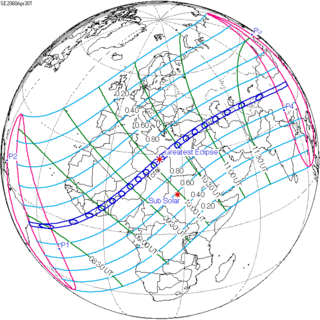
A total solar eclipse will occur on April 30, 2060. A solar eclipse occurs when the Moon passes between Earth and the Sun, thereby totally or partly obscuring the image of the Sun for a viewer on Earth. A total solar eclipse occurs when the Moon's apparent diameter is larger than the Sun's, blocking all direct sunlight, turning day into darkness. Totality occurs in a narrow path across Earth's surface, with the partial solar eclipse visible over a surrounding region thousands of kilometres wide.

A total solar eclipse will occur on May 11, 2078. A solar eclipse occurs when the Moon passes between Earth and the Sun, thereby totally or partly obscuring the image of the Sun for a viewer on Earth. A total solar eclipse occurs when the Moon's apparent diameter is larger than the Sun's, blocking all direct sunlight, turning day into darkness. Totality occurs in a narrow path across Earth's surface, with the partial solar eclipse visible over a surrounding region thousands of kilometres wide.

A total solar eclipse will occur on May 23, 2096. A solar eclipse occurs when the Moon passes between Earth and the Sun, thereby totally or partly obscuring the image of the Sun for a viewer on Earth. A total solar eclipse occurs when the Moon's apparent diameter is larger than the Sun's, blocking all direct sunlight, turning day into darkness. Totality occurs in a narrow path across Earth's surface, with the partial solar eclipse visible over a surrounding region thousands of kilometres wide. This will be the first eclipse of saros series 139 to exceed series 136 in length of totality. The length of totality for saros 139 is increasing, while that of Saros 136 is decreasing.
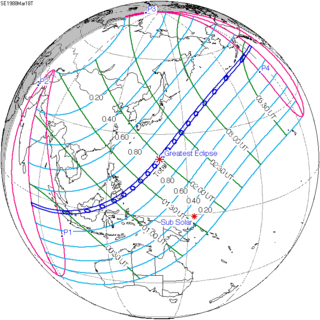
A total solar eclipse occurred on March 18, 1988. A solar eclipse occurs when the Moon passes between Earth and the Sun, thereby totally or partly obscuring the image of the Sun for a viewer on Earth. A total solar eclipse occurs when the Moon's apparent diameter is larger than the Sun's, blocking all direct sunlight, turning day into darkness. Totality occurs in a narrow path across Earth's surface, with the partial solar eclipse visible over a surrounding region thousands of kilometres wide. Totality was visible in Indonesia and southern Philippines.
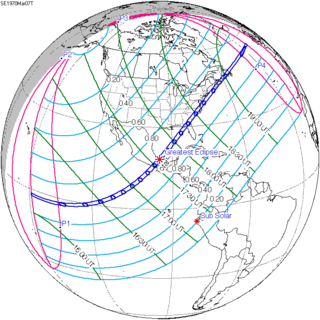
A total solar eclipse occurred on March 7, 1970, visible across most of North America and Central America.

A total solar eclipse occurred on February 25, 1952. A solar eclipse occurs when the Moon passes between Earth and the Sun, thereby totally or partly obscuring the image of the Sun for a viewer on Earth. A total solar eclipse occurs when the Moon's apparent diameter is larger than the Sun's, blocking all direct sunlight, turning day into darkness. Totality occurs in a narrow path across Earth's surface, with the partial solar eclipse visible over a surrounding region thousands of kilometres wide. The path of totality crossed Africa, the Middle East, and Asia.

A total solar eclipse occurred on February 14, 1934. A solar eclipse occurs when the Moon passes between Earth and the Sun, thereby totally or partly obscuring the image of the Sun for a viewer on Earth. A total solar eclipse occurs when the Moon's apparent diameter is larger than the Sun's, blocking all direct sunlight, turning day into darkness. Totality occurs in a narrow path across Earth's surface, with the partial solar eclipse visible over a surrounding region thousands of kilometres wide. Totality was visible from the Dutch East Indies, North Borneo, and South Pacific Mandate in Japan.

A total solar eclipse occurred on February 3, 1916. A solar eclipse occurs when the Moon passes between Earth and the Sun, thereby totally or partly obscuring the image of the Sun for a viewer on Earth. A total solar eclipse occurs when the Moon's apparent diameter is larger than the Sun's, blocking all direct sunlight, turning day into darkness. Totality occurs in a narrow path across Earth's surface, with the partial solar eclipse visible over a surrounding region thousands of kilometres wide. Totality was visible in Colombia, Venezuela, and the whole Guadeloupe except Marie-Galante, Saint Martin and Saint Barthélemy.

A total solar eclipse will occur on July 16, 2186, which will be the longest total eclipse for thousands of years. The eclipse will pass over the southern Galápagos Islands, the northern tip of Ecuador, central Colombia, central Venezuela, and northern Guyana.
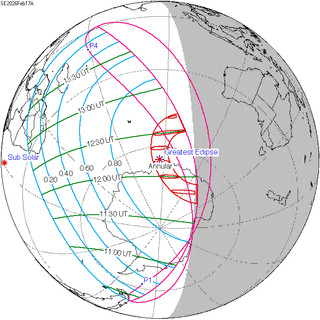
An annular solar eclipse will occur on February 17, 2026. A solar eclipse occurs when the Moon passes between Earth and the Sun, thereby totally or partly obscuring the image of the Sun for a viewer on Earth. An annular solar eclipse occurs when the Moon's apparent diameter is smaller than the Sun's, blocking most of the Sun's light and causing the Sun to look like an annulus (ring). An annular eclipse appears as a partial eclipse over a region of the Earth thousands of kilometres wide.

A total solar eclipse occurred on June 8, 1937. A solar eclipse occurs when the Moon passes between Earth and the Sun, thereby totally or partly obscuring the image of the Sun for a viewer on Earth. A total solar eclipse occurs when the Moon's apparent diameter is larger than the Sun's, blocking all direct sunlight, turning day into darkness. Totality occurs in a narrow path across Earth's surface, with the partial solar eclipse visible over a surrounding region thousands of kilometres wide. The path of totality crossed the Pacific Ocean starting in Gilbert and Ellice Islands on June 9th, and ending at sunset in Peru on June 8th (Tuesday). At sunrise totality lasted 3 minutes, 6.8 seconds and at sunset totality lasted 3 minutes, 5.1 seconds. American astronomy professor Ethelwynn Rice Beckwith traveled to Peru to see this eclipse, and described the event in detail for the Oberlin Alumnae Magazine in 1937, in an article titled "Three Minutes in Peru."

A total solar eclipse will occur on May 1, 2079, with a maximum eclipse at 10:48:25.6 UTC. A solar eclipse occurs when the Moon passes between Earth and the Sun, thereby totally or partly obscuring the image of the Sun for a viewer on Earth. A total solar eclipse occurs when the Moon's apparent diameter is larger than the Sun's, blocking all direct sunlight, turning day into darkness. Totality occurs in a narrow path across Earth's surface, with the partial solar eclipse visible over a surrounding region thousands of kilometres wide. The eclipse will be visible in Greenland, parts of eastern Canada and parts of the northeastern United States .[

A total solar eclipse will occur on July 5, 2168. A solar eclipse occurs when the Moon passes between Earth and the Sun, thereby totally or partly obscuring the image of the Sun for a viewer on Earth. A total solar eclipse occurs when the Moon's apparent diameter is larger than the Sun's, blocking all direct sunlight, turning day into darkness. Totality occurs in a narrow path across Earth's surface, with the partial solar eclipse visible over a surrounding region thousands of kilometres wide. Lasting a maximum of 7 minutes, 26 seconds, it will be the longest eclipse since the 11th century, which lasted 7 minutes and 20 seconds, as well with the next two occurrences. This is the largest total solar eclipse of Saros 139. Greatest Eclipse occurs 1,468 km north of the Equator.
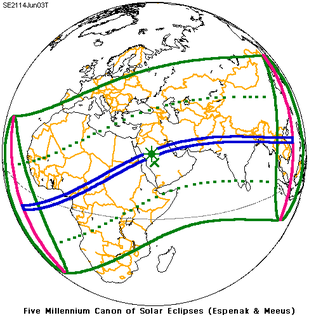
There will be a total solar eclipse on June 3, 2114. A solar eclipse occurs when the Moon passes between Earth and the Sun, thereby totally or partly obscuring the image of the Sun for a viewer on Earth. A total solar eclipse occurs when the Moon's apparent diameter is larger than the Sun's, blocking all direct sunlight, turning day into darkness. Totality occurs in a narrow path across Earth's surface, with the partial solar eclipse visible over a surrounding region thousands of kilometres wide.

An annular solar eclipse occurred on December 14, 1917. A solar eclipse occurs when the Moon passes between Earth and the Sun, thereby totally or partly obscuring the image of the Sun for a viewer on Earth. An annular solar eclipse occurs when the Moon's apparent diameter is smaller than the Sun's, blocking most of the Sun's light and causing the Sun to look like an annulus (ring). An annular eclipse appears as a partial eclipse over a region of the Earth thousands of kilometres wide.













